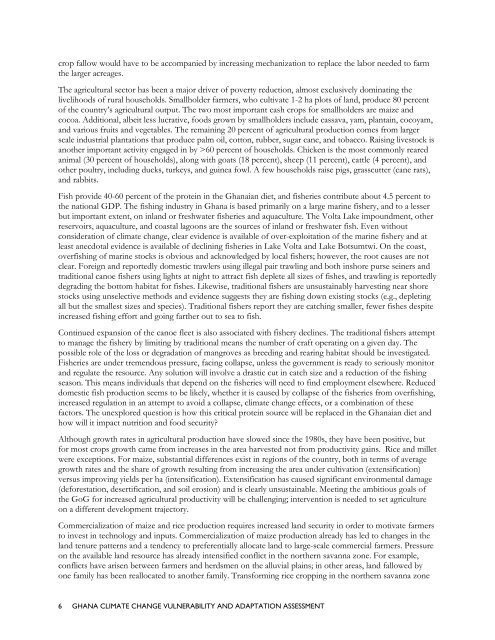ghana climate change vulnerability and adaptation assessment
ghana climate change vulnerability and adaptation assessment
ghana climate change vulnerability and adaptation assessment
- No tags were found...
You also want an ePaper? Increase the reach of your titles
YUMPU automatically turns print PDFs into web optimized ePapers that Google loves.
crop fallow would have to be accompanied by increasing mechanization to replace the labor needed to farmthe larger acreages.The agricultural sector has been a major driver of poverty reduction, almost exclusively dominating thelivelihoods of rural households. Smallholder farmers, who cultivate 1-2 ha plots of l<strong>and</strong>, produce 80 percentof the country’s agricultural output. The two most important cash crops for smallholders are maize <strong>and</strong>cocoa. Additional, albeit less lucrative, foods grown by smallholders include cassava, yam, plantain, cocoyam,<strong>and</strong> various fruits <strong>and</strong> vegetables. The remaining 20 percent of agricultural production comes from largerscale industrial plantations that produce palm oil, cotton, rubber, sugar cane, <strong>and</strong> tobacco. Raising livestock isanother important activity engaged in by >60 percent of households. Chicken is the most commonly rearedanimal (30 percent of households), along with goats (18 percent), sheep (11 percent), cattle (4 percent), <strong>and</strong>other poultry, including ducks, turkeys, <strong>and</strong> guinea fowl. A few households raise pigs, grasscutter (cane rats),<strong>and</strong> rabbits.Fish provide 40-60 percent of the protein in the Ghanaian diet, <strong>and</strong> fisheries contribute about 4.5 percent tothe national GDP. The fishing industry in Ghana is based primarily on a large marine fishery, <strong>and</strong> to a lesserbut important extent, on inl<strong>and</strong> or freshwater fisheries <strong>and</strong> aquaculture. The Volta Lake impoundment, otherreservoirs, aquaculture, <strong>and</strong> coastal lagoons are the sources of inl<strong>and</strong> or freshwater fish. Even withoutconsideration of <strong>climate</strong> <strong>change</strong>, clear evidence is available of over-exploitation of the marine fishery <strong>and</strong> atleast anecdotal evidence is available of declining fisheries in Lake Volta <strong>and</strong> Lake Botsumtwi. On the coast,overfishing of marine stocks is obvious <strong>and</strong> acknowledged by local fishers; however, the root causes are notclear. Foreign <strong>and</strong> reportedly domestic trawlers using illegal pair trawling <strong>and</strong> both inshore purse seiners <strong>and</strong>traditional canoe fishers using lights at night to attract fish deplete all sizes of fishes, <strong>and</strong> trawling is reportedlydegrading the bottom habitat for fishes. Likewise, traditional fishers are unsustainably harvesting near shorestocks using unselective methods <strong>and</strong> evidence suggests they are fishing down existing stocks (e.g., depletingall but the smallest sizes <strong>and</strong> species). Traditional fishers report they are catching smaller, fewer fishes despiteincreased fishing effort <strong>and</strong> going farther out to sea to fish.Continued expansion of the canoe fleet is also associated with fishery declines. The traditional fishers attemptto manage the fishery by limiting by traditional means the number of craft operating on a given day. Thepossible role of the loss or degradation of mangroves as breeding <strong>and</strong> rearing habitat should be investigated.Fisheries are under tremendous pressure, facing collapse, unless the government is ready to seriously monitor<strong>and</strong> regulate the resource. Any solution will involve a drastic cut in catch size <strong>and</strong> a reduction of the fishingseason. This means individuals that depend on the fisheries will need to find employment elsewhere. Reduceddomestic fish production seems to be likely, whether it is caused by collapse of the fisheries from overfishing,increased regulation in an attempt to avoid a collapse, <strong>climate</strong> <strong>change</strong> effects, or a combination of thesefactors. The unexplored question is how this critical protein source will be replaced in the Ghanaian diet <strong>and</strong>how will it impact nutrition <strong>and</strong> food security?Although growth rates in agricultural production have slowed since the 1980s, they have been positive, butfor most crops growth came from increases in the area harvested not from productivity gains. Rice <strong>and</strong> milletwere exceptions. For maize, substantial differences exist in regions of the country, both in terms of averagegrowth rates <strong>and</strong> the share of growth resulting from increasing the area under cultivation (extensification)versus improving yields per ha (intensification). Extensification has caused significant environmental damage(deforestation, desertification, <strong>and</strong> soil erosion) <strong>and</strong> is clearly unsustainable. Meeting the ambitious goals ofthe GoG for increased agricultural productivity will be challenging; intervention is needed to set agricultureon a different development trajectory.Commercialization of maize <strong>and</strong> rice production requires increased l<strong>and</strong> security in order to motivate farmersto invest in technology <strong>and</strong> inputs. Commercialization of maize production already has led to <strong>change</strong>s in thel<strong>and</strong> tenure patterns <strong>and</strong> a tendency to preferentially allocate l<strong>and</strong> to large-scale commercial farmers. Pressureon the available l<strong>and</strong> resource has already intensified conflict in the northern savanna zone. For example,conflicts have arisen between farmers <strong>and</strong> herdsmen on the alluvial plains; in other areas, l<strong>and</strong> fallowed byone family has been reallocated to another family. Transforming rice cropping in the northern savanna zone6 GHANA CLIMATE CHANGE VULNERABILITY AND ADAPTATION ASSESSMENT
















